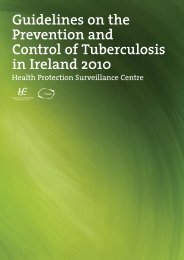Guidelines for the Early Clinical and Public Health Management of ...
Guidelines for the Early Clinical and Public Health Management of ...
Guidelines for the Early Clinical and Public Health Management of ...
Create successful ePaper yourself
Turn your PDF publications into a flip-book with our unique Google optimized e-Paper software.
<strong>Guidelines</strong> <strong>for</strong> <strong>the</strong> <strong>Early</strong> <strong>Clinical</strong> <strong>and</strong> <strong>Public</strong> <strong>Health</strong> <strong>Management</strong> <strong>of</strong> Bacterial Meningitis (including Meningococcal Disease)<br />
ii. Communication with health care pr<strong>of</strong>essionals<br />
The health care pr<strong>of</strong>essionals (GPs, emergency medicine consultant, o<strong>the</strong>r hospital clinicians) in <strong>the</strong> area should<br />
be updated on <strong>the</strong> situation <strong>and</strong> asked to refer <strong>and</strong> report any suspect cases immediately. Communications<br />
should highlight <strong>the</strong> importance <strong>of</strong> early diagnosis, empirical treatment <strong>and</strong> prompt notification <strong>of</strong> suspect cases.<br />
Emergency department physicians <strong>and</strong> o<strong>the</strong>r clinicians seeing patients should be advised to collect blood cultures<br />
<strong>and</strong> throat swabs be<strong>for</strong>e administration <strong>of</strong> <strong>the</strong> first dose <strong>of</strong> antibiotics if possible. Treatment <strong>and</strong> referral should never<br />
be delayed if specimen collection cannot be rapidly taken. Hospital clinicians are encouraged to take throat swabs<br />
as well as blood cultures from persons suspected <strong>of</strong> having meningococcal disease as prior antibiotic <strong>the</strong>rapy may<br />
render blood <strong>and</strong> CSF cultures sterile.<br />
Advice relating to pre-admission antibiotics is discussed in <strong>the</strong> section on clinical management.<br />
iii. The community at large<br />
Disseminating in<strong>for</strong>mation to <strong>the</strong> community may require use <strong>of</strong> mass media, websites, community meetings <strong>and</strong><br />
help lines.<br />
iv. The media<br />
The outbreak control team should agree on a single spokesperson who is experienced in dealing with <strong>the</strong> media. A<br />
senior experienced spokesperson is usually best suited to this role.<br />
8.6 Response related to specific settings<br />
8.6.1 Setting based outbreaks<br />
Populations at risk in closed settings such as schools <strong>and</strong> crèches/preschool facilities are usually relatively easily<br />
defined. However, identification <strong>of</strong> populations at risk in o<strong>the</strong>r larger settings (e.g. universities) with less defined<br />
networks <strong>and</strong> close contacts may be more difficult.<br />
When two or more cases are reported from an educational setting, public health should undertake a careful <strong>and</strong><br />
rapid assessment <strong>of</strong> <strong>the</strong> apparent cluster. The review should include <strong>the</strong> following;<br />
• The clinical features <strong>of</strong> <strong>the</strong> cases<br />
• Microbiological data (serogroup <strong>and</strong> subtype)<br />
• Dates <strong>of</strong> illness onset <strong>and</strong> dates <strong>of</strong> last attendance at <strong>the</strong> site<br />
• Epidemiological links between cases (age, class or school year, home address, social activities, friends)<br />
• Numbers <strong>of</strong> students in <strong>the</strong> school <strong>and</strong> in each school year<br />
• The public health management options include<br />
o Giving in<strong>for</strong>mation out to students/staff/parents only<br />
o Giving out in<strong>for</strong>mation <strong>and</strong> <strong>of</strong>fering wider prophylaxis in <strong>the</strong> school or education setting.<br />
If following investigation it is considered that <strong>the</strong> cases do not meet <strong>the</strong> case definition <strong>for</strong> meningococcal disease,<br />
fur<strong>the</strong>r action may not be indicated.<br />
8.6.2 <strong>Public</strong> health action<br />
Chemoprophylaxis<br />
In responding to setting specific outbreaks, chemoprophylaxis is considered <strong>for</strong> a wider group than solely close<br />
contacts even though <strong>the</strong> evidence to support <strong>the</strong> use <strong>of</strong> chemoprophylaxis to prevent fur<strong>the</strong>r cases is not strong. The<br />
target group should be a discrete group that contains <strong>the</strong> cases <strong>and</strong> makes sense to staff/parents/students. Once a<br />
specific group is identified prompt action is recommended.<br />
Close contacts should be provided with chemoprophylaxis as <strong>for</strong> sporadic cases (see Section 7.2 on<br />
chemoprophylaxis following exposure).<br />
Co-primary or secondary cases who are identified as being close contacts <strong>of</strong> <strong>the</strong> index case are assumed (unless<br />
microbiological evidence is to <strong>the</strong> contrary) to have acquired <strong>the</strong>ir disease as a result <strong>of</strong> this close householdlike<br />
contact. Such cases are not counted when deciding whe<strong>the</strong>r to <strong>of</strong>fer setting based chemoprophylaxis (o<strong>the</strong>r<br />
than in childcare settings). For example, two probable cases in university students in <strong>the</strong> same class who share<br />
accommodation are assumed to been exposed in a household-like setting <strong>of</strong> <strong>the</strong> shared accommodation ra<strong>the</strong>r than<br />
in class. 3<br />
-70-

















